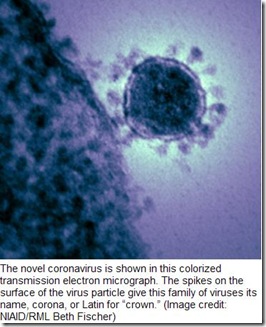hat tip Michael Coston
Wednesday, March 13, 2013
Nature: Receptor For NCoV Found

Photo Credit NIAID
# 7004
A fairly technical report appears in the Journal Nature today - produced by research teams in both Europe and Saudi Arabia - that establishes the mechanism by which the novel Coronavirus NCoV (here called hCoV-EMC) binds to, and infects, mammalian cells.
They found this novel coronavirus uses a well known cell surface protein called dipeptidyl peptidase 4 (DPP4) to enter and infect human cells.
Wednesday, March 13, 2013
Nature: Receptor For NCoV Found

Photo Credit NIAID
# 7004
A fairly technical report appears in the Journal Nature today - produced by research teams in both Europe and Saudi Arabia - that establishes the mechanism by which the novel Coronavirus NCoV (here called hCoV-EMC) binds to, and infects, mammalian cells.
They found this novel coronavirus uses a well known cell surface protein called dipeptidyl peptidase 4 (DPP4) to enter and infect human cells.
This DPP4 cell surface protein (also called CD26) is evolutionarily conserved in other species, including bats (suspected of being potential species), non-human primates, and other animals ? all of which suggests that this virus might be able to infect a wide range of hosts.
Working in vitro with Vero & COS-7 cells (African Green Monkey kidneys), Huh-7 (human hepato-carcinoma) and kidney cells of the P. pipistrellus bat, researchers found how hCoV-EMC?s receptor-binding domain latched onto cells. Using protein-specific antibodies, they were able to block specific receptors, systematically narrowing the field of possible attachment sites.
When DPP4 proteins were blocked, the virus was no longer able to attach to cells and cause infection. A discovery that could potentially lead to some specific treatment for this virus down the line. These are, of course, early days. And we still know very little about the origin ? and the potential ? of this virus.
The researchers point out that (in humans) DPP4 is primarily expressed by epithelial cells in the in kidney, small intestine, liver and prostate. They also observed that DPP4 is expressed by non-ciliated bronchial epithelial cells of the upper airway. Locations consistent with the clinical picture of infection we?ve seen over the past year, that has often included both pneumonia and renal failure.
Declan Butler at Nature has far more on all of this, after which you?ll find a link to the study. Receptor for new coronavirus found
Virus might have many animal reservoirs.
Declan Butler 13 March 2013
And the study?s abstract can be found at:Virus might have many animal reservoirs.
Declan Butler 13 March 2013
Dipeptidyl peptidase 4 is a functional receptor for the emerging human coronavirus-EMC
V. Stalin Raj, Huihui Mou, Saskia L. Smits, Dick H. W. Dekkers, Marcel A. M?ller, Ronald Dijkman, Doreen Muth, Jeroen A. A. Demmers, Ali Zaki, Ron A. M. Fouchier, Volker Thiel, Christian Drosten, Peter J. M. Rottier, Albert D. M. E. Osterhaus, Berend Jan Bosch & Bart L. Haagmans
Posted by Michael Coston at <a class="timestamp-link" href="http://afludiary.blogspot.com/2013/03/nature-receptor-for-ncov-found.html" rel="bookmark" title="permanent link"><abbr class="published" title="2013-03-13T14:32:00-04:00">2:32 PM</abbr> V. Stalin Raj, Huihui Mou, Saskia L. Smits, Dick H. W. Dekkers, Marcel A. M?ller, Ronald Dijkman, Doreen Muth, Jeroen A. A. Demmers, Ali Zaki, Ron A. M. Fouchier, Volker Thiel, Christian Drosten, Peter J. M. Rottier, Albert D. M. E. Osterhaus, Berend Jan Bosch & Bart L. Haagmans
Comment